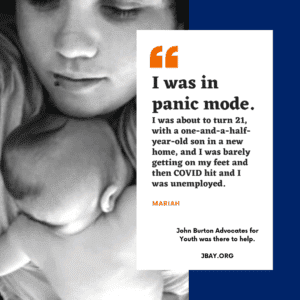 Resiliency has been the buzz word for 2020. It has been a year of challenges and adversity for everyone. There is confusion. There is fear. Yet, we do our best to overcome the hardships.
Resiliency has been the buzz word for 2020. It has been a year of challenges and adversity for everyone. There is confusion. There is fear. Yet, we do our best to overcome the hardships.
As difficult as the pandemic has been for all of us, children and youth who are homeless or in foster care face these same fears, confusion, and more every day—even before 2020. This year it was even more difficult:
- Mass layoffs—especially in retail jobs these young people rely on—have left them without any income.
- College closures left them with nowhere to live. Even after colleges reopened online, campus housing often remained closed.
- Schools that were also a source of food and support closed. When they opened virtually, most foster and homeless youths had no access to the internet, let alone the technology needed to succeed.
They try to stay resilient in a world that has almost forgotten them. But it’s been so hard.
John Burton Advocates for Youth (JBAY) did not forget them. Instead of slowing down or even closing temporarily, we swiftly pivoted to help at-risk youth face the challenges in these uncertain times. And we continued our usual busy schedule of advocacy, training, and support.
Here are some of the ways we supported homeless and foster youth in 2020:
Emergency Support from JBAY
As soon as the pandemic hit in March, JBAY mobilized to raise more than $400,000 to purchase around 3,000 laptops for foster youth, who would have otherwise dropped out of college when distance learning was the only option. JBAY’s response was praised by Governor Newsom in a press conference about helping foster youth during the pandemic.
Then in May, we established an emergency response fund providing critically needed assistance to more than 500 foster youth attending college to support them with essential housing, food, and transportation needs.
Emergency Action with the Governor
Working with Governor Newsom, we helped foster youth who would age out of foster care at 21 and lose their housing and support during the pandemic. An Emergency Order and $32 million investment protected these youth, allowing them to remain in foster care until June 30, 2021. California was the first state in the nation to take this action and the federal government followed suit shortly after, issuing policy guidance to states.
New Legislation
When the legislature in Sacramento sharply reduced the number of bills it would consider this year, JBAY continued to successfully fight for better laws to protect foster and homeless youth.
In September, Governor Newsom signed two JBAY sponsored bills into law:
- Senate Bill 860: Improving college access for foster youth—increases participation in college among foster youth by requiring state-funded agencies to assist foster youth in completing their Free Application for Federal Student Aid (FAFSA). This builds on JBAY’s California FAFSA Campaign, which increased college aid applications by foster youth from 45% in 2017 to 64% in 2020.
- Assembly Bill 2416: Maintaining financial aid for foster youth and other vulnerable college students who become homeless—requires colleges to consider homelessness as an extenuating circumstance when students appeal the loss of financial aid.
While the California legislature was working to make deep cuts to its 2020-21 budget, we advocated to keep these at-risk youth safe. Not only were there no budget cuts to any essential programs, but we secured an increase in support to foster youth totaling $60 million this year.
“It’s been a trying year for everyone,” says Amy Lemley, executive director of JBAY. “But it’s so much harder without a family and no resources to draw upon in an emergency. We are proud that JBAY has made such a difference in thousands of lives, despite the hardest year I’ve ever known. With the support of donors, legislators and front-line workers, we will ensure that at-risk youth will not only survive 2020 but thrive in 2021 and beyond. That’s what resilience should mean.”
